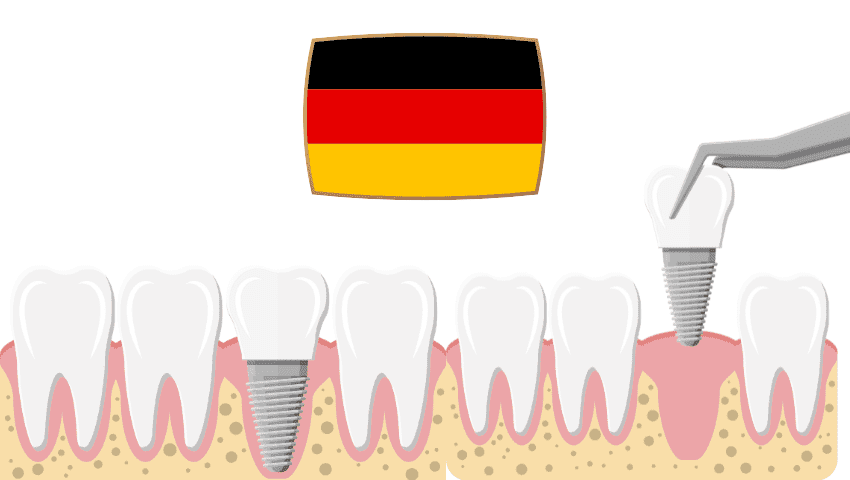Dental implants in Germany .. Your full guide 2023
In this article, we will cover everything you need to know about dental implants in Germany, from the costs and prices, to the best producers and more.
Dental implants may restore missing teeth permanently. Dental implants are replacement tooth roots that are surgically placed into the jaw. This method is used to replace teeth that have been lost.

What is the cost of a dental implants in Germany ?
A treatment for dental implants with bone augmentation can cost several thousand euros. In order to protect yourself against high costs , it is advisable to take out private supplementary dental insurance. Anyone who already has supplementary dental insurance should check whether it also covers benefits for dental implants, including bone formation, at a good price-performance ratio. If not, changing your supplementary dental insurance can definitely be worthwhile in order to save high costs if the worst comes to the worst.
The test winner (Stiftung Warentest) DFV-ZahnSchutz Exklusiv 100, which also covers the costs for bone formation in addition to implants and dentures, is particularly powerful.
| sample calculation dental implant | Base (50%) | Comfort (70%) | Premier (90%) | Exclusive (100%) |
| Statutory health insurance | €374 | €374 | €374 | €374 |
| DFV supplementary dental insurance | €913 | €1,278 | €1,683 | €1,826 |
| Own contribution | €913 | €561 | €143 | €0 |
Dental implants: Big differences in personal contributions
How much money should a patient expect to pay for a dental implant in the end? The costs range from under 1,000 euros to over 4,000 euros. The individual effort and the selected material can drive up the costs. On average, you have to reckon with a personal contribution of 1,000 to 1,500 euros. It gets really expensive when several tooth gaps are to be filled with implants: 5,000 to 10,000 euros are not uncommon for such treatments.
In many cases, bone augmentation must be carried out before the implant is placed. Statutory health insurance does not cover the costs, which can often be between 400 and 1,500 euros. In the end, the patient has to foot the bill. Incidentally, the removal of an old implant is not covered by health insurance. Here you have to reckon with 20 to 100 euros.
Since implants are not a standard benefit of the statutory health insurance companies, there is no subsidy from the office. However, what applies, at least for dentures, is the bonus scheme. The fixed subsidy increases by 20% after 5 years and 30% after 10 years.
Dental implant costs at a glance
The cost of dental implants varies depending on which area of the tooth is affected . A little overview:
- Single implant in the front tooth area approx. 1,400 to 3,000 euros
- Single implant in the molar area approx. 1,000 to 2,500 euros
- Implant-supported dental bridge approx. 3,500 to 5,000 euros
How are the costs broken down in detail? An example calculation:
An implant with a veneered metal-ceramic crown in the non-visible jaw area
| bone formation | 1,400 euros |
| implant | 1,530 euros |
| superstructure | 900 euros |
| total cost | 3,830 euros |
| Less cash benefits (incl. maximum bonus) | 429 euros |
| Own contribution for the patient | 3,401 euros |
Cost protection for dental implants
The bottom line is that implant treatment with bone augmentation can cost several thousand euros. Many then “plunder” their holiday funds or take out an expensive loan. Better and much cheaper is the protection with a private supplementary dental insurance.
The DFV tooth protection exclusive 100 is particularly powerful and covers not only the implant and the dentures but also the costs for bone augmentation. The tariff of the Deutsche Familienversicherung was awarded the absolute top rating VERY GOOD (0.5) by Stiftung Warentest Finanztest (04/2021) among 244 supplementary dental insurance policies tested.
What is a dental implant?
A dental implant is an artificial tooth root that is surgically inserted into the jawbone by a dental specialist. The implant serves as a carrier for the denture (implant body) – e.g. B. for a crown , bridge or removable dentures . Dental implants can not only replace a single tooth, but – if necessary – also several lost teeth. Dental implants are considered a stable, aesthetic and functional solution to replace lost teeth with a perfect fit. In the best case, the dentures are indistinguishable from the natural teeth.
Implants with the associated dentures not only mean an increase in quality of life, but are also very useful from a medical point of view. The reason: Dental implants can prevent bone loss by transferring the chewing forces directly to the jawbone. It is therefore very important not to wait too long before inserting an implant, because in the worst case the bone has already receded to such an extent that consequential damage to health can be expected.
What elements does a dental implant consist of?
Implants are usually made up of three components. These include the implant body, the implant structure (abutment) and the implant crown.
implant body
The implant body forms the basis for an implant. The implant body is surgically implemented in the jawbone as an “artificial tooth root”. This implant body, which is usually cylindrical in shape, is usually firmly anchored in the jawbone via a thread. After a healing phase, the implant abutment and the implant crown can be inserted.
Implant structure (abutment)
The implant abutment – known in technical terms as an abutment – is a precisely fitting titanium or ceramic connection that serves as an intermediate link between the implant body and the implant crown. Abutments have a connector on both sides. It can be screwed to the implant body on one side and to the implant crown on the other side.
implant crown
The denture attached to the implant is called an implant crown . Implant crowns are usually made by specialized dental technicians. The fixation with the implant takes place via screws and sockets (implant posts) and often with the help of a medical cement. Implant crowns are usually made of gold or titanium or ceramic. There are also implant crowns made of both materials. In particular, the high-priced ceramic crowns are considered to be particularly compatible with the body and can perfectly replicate the natural tooth.
Classification of dental implants by type
Placing an implant is a routine procedure these days. Different types of implants enable individual solutions for the patient, depending on the clinical picture. The diameter of implants is 3.3 to 5 millimeters. In terms of length, the scope is between 8 and 15 millimeters. That depends entirely on the individual implant situation and also on the condition of the jaw.
Implants are divided into one-piece and two-piece systems, according to their structure (joints, grooves, perforations), but also according to different shapes, materials, surface finishes and types.
- Subdivision of implants according to shape: conical, stepped, leaf-shaped, needle-shaped and cylindrical
- Subdivision of implants according to the material: titanium and ceramic.
- Subdivision of the implants according to the surface finish: etched, blasted with titanium or sandblasted
- Subdivision of the implants according to systems: one-piece and two-piece systems
- Subdivision of implants by type: from quick implants to mini implants to tilting and interim implants
Classification according to implant shapes
Before the implant is placed in the jawbone, the right shape must be chosen. The selection that a maxillofacial surgeon has is extensive. Among other things, a distinction is made between:
- Cylindrical implants without thread: They gain their primary stability through the specific press adjustment, i.e. through the clamping effect of the implant in the jawbone.
- Stepped implants: either as cylinder or screw implants.
- Conical implants: such as screw implants or stepped cylinder implants. Screw implants have self-tapping or pre-tapping threads. As a result, they also gain good primary stability. Self-tapping threads are usually chosen. When screwing in the implant, the thread is cut into the jawbone at the same time.
The majority of today’s implants have a screw shape. The only differences are in width, length and thread profile. In the past, blade implants, disk implants and also needle implants were often used. These forms are now rarely used.
Classification according to implant material
The material of dental implants must meet high requirements, because implants should remain in the body for a long time. Therefore, implantologists usually choose biocompatible materials with high strength, which are well tolerated and grow firmly with the surrounding tissue and bone. As a rule, dental implants are made of pure titanium or a titanium alloy, since there are no allergic or repellent reactions. But ceramic implants are also well tolerated and score points in terms of aesthetics with their white color.
Dental implants today are mostly made of the following materials:
Titanium Implants: Titanium is the most common material used for dental implants. The biocompatibility of pure titanium is very good, and there are neither intolerance reactions nor allergies. Thanks to its surface structure, titanium can form a firm bond with the jawbone.
Ceramic implants: Ceramic (zirconium oxide) implants are also very durable. The white color of the material also meets high aesthetic demands. Because of their similarity to the natural tooth substance, ceramic implants represent a high-quality metal-free alternative. They are also suitable for allergy sufferers due to their very good compatibility.
The treating implantologist can best assess which material is most suitable based on his or her experience.
Classification according to implant surface properties
The surface of the implant (outer surface of the implant body) is in direct contact with the body tissue and therefore influences healing, stability and durability. An ideal implant surface can optimize biological reactions between the implant and the jawbone in both titanium implants and ceramic implants (zirconia dental implants). In this way, for example, an early loading of the implant can be achieved. A roughened surface has become established.
Today, the surface properties of implants are usually as follows:
- corroded
- irradiated with titanium
- sandblasted
Classification according to implant systems
A distinction is made between two implant systems: the one-piece and the two-piece system. The two-part or multi-part implant system has meanwhile prevailed over the one-part one.
One-piece implant system
This system consists of only one part. Because of its small diameter, it is often used in small tooth gaps. Since the implant head protrudes from the mucous membrane after insertion, problems sometimes arise during the healing phase.
Also read: Doctor salary in Germany
Two-part implant system
With this system, an implant is placed in the jawbone. After insertion into the bone, the implant screw is closed with a cover disk and then covered by the gum. The dental implant can heal well. The implant neck and the implant crown, for example an all-ceramic crown, are then screwed onto it. It is also an advantage of this two-part variant that the shape and angle of the implant abutment can be selected later. In this way, the dentures can be inserted into the row of teeth in the best possible way. In addition, the screwed-together implant parts largely prevent the implant from being stressed during the healing time.
Classification according to implant types
There is a wide range of implants for the different anatomical conditions in the jaw of patients. In the range of common implants, the oral surgeon can choose between numerous types and sizes. Some are intended for immediate restoration, others are preferred in cases of low bone status or low bone density, and others are intended for specific areas of the jaw.
Overview of implant types:
Rapid implants: They are placed in the jawbone immediately after the tooth has been removed and fitted with dentures. The work steps take place in one session. Extremely precise planning with digital measurement of the jaw and ready-prepared structure and dentures is important here. This variant is suitable when there is sufficient bone and the primary stability of the rapid implant.
Narrow implants: These small dental implants are used in the front tooth area. They are very delicate and are used in horizontal recession of the jawbone, full dentures and other complicated tooth replacement treatments. The models, also known as diameter-reduced implants, have proven particularly effective in the single-tooth restoration of very narrow gaps in the upper jaw. They are often used as an alternative to orthodontic treatment with braces.
Mini-implants: They are mainly used when using full dentures and bridges, as well as in orthodontics and as an interim tooth replacement. The one-piece implants have a smaller diameter than conventional models. They are screwed into the jawbone, leaving a small area above the oral mucosa for anchoring the prosthesis. Mini-implants close narrow tooth gaps well and are also used for immediate loading of implants when there is little bone available.
Ultra-short implants: They are chosen in particular when difficult anatomical conditions require better load distribution. The very short implants have a large diameter and are therefore well suited if, for example, there is only little bone left in the side tooth area of the upper or lower jaw. This often occurs, among other things, after a long ago tooth extraction and non-supply with dental implants.
Tilting implants: These narrow, beveled implants are chosen by maxillofacial surgeons when there is little bone left. One advantage of tilting implants is, among other things, the avoidance of bone formation.
Conical implants: These implants are mostly used as screw implants. They are preferably used when there is only a small amount of bone in the upper jaw and also when bone density is low.
Interim implants: They represent a temporary solution. The very thin dental implants serve as a transition to immediate restoration – during the healing phase of the final implant. Interim implants are easy to insert and just as easy to remove.
Zygomatic implants: These very long implants (five centimeters) are anchored in the cheekbone at a 45 degree angle. Due to its particularly dense bone structure, it offers the best conditions for holding the zygomatic implant. It is mainly used when the use of conventional implants promises little success. For example, if the upper bone shows significant bone loss and a bone transplant is no longer possible or not desired.
Best dental implants producers in Germany
Which implant manufacturers are there?
There are currently more than 100 manufacturers of implants whose implant systems are available in Germany. The dental implants have their origins in the same basic idea, but they differ significantly in some features, such as material and size. Below is a market overview* of recognized implant manufacturers in Germany.
Implant manufacturers at a glance
The manufacturers of dental implants approved in Germany come from Germany, France, Israel, Korea, Switzerland, Sweden and the USA. Their implant systems differ primarily in their design, surface finish and variety of structures. These properties determine the cost of implants.
List of recognized implant manufacturers
Some manufacturers already have many years of experience in the field of implant systems and are constantly developing their product range. But newer manufacturers are also enriching the market with the latest generation of dental implants.
- 3M
- Alpha Bio Ltd.
- anthogyr
- Argon Medical GmbH & Co. KG
- Aurosan GmbH
- BEGO Implant Systems GmbH & Co. KG
- Bicon Dental Implants
- Biodenta
- BioHorizons®
- BIOMET 3i Inc.
- Paltop Dental Solutions Ltd.
- bredent medical GmbH & Co. KG
- BTI Biotechnology Institute, SL
- ALTATEC GmbH
- Champions Implants GmbH
- Clinical House Europe GmbH
- CORTEX Dental Implants Ltd.
- C-TECH/Century Implant Technologies
- Cumdente GmbH
- Dentalpoint AG
- Hager & Meisinger GmbH
- Dentaurum Implants GmbH
- Dentium Co.Ltd.
- Dentsply Sirona Implants
- dr Ihde Dental AG
- drive implants
- Dyna Dental Engineering bv
- FairImplant GmbH
- General Implants GmbH
- HAI IMPLANT GmbH
- FMZ GmbH, Rostock
- HI-TEC IMPLANTS Ltd.
- Implants Diffusion International
- Hager & Meisinger GmbH
- ARDS Implants Smart
- Implant Direct
- General Implants
- Impreglon Material Technology GmbH
- Indi Implant Systems GmbH
- Medentika
- Keystone Dental Ltd
- KSI Bauer-Schraube GmbH
- LASAK Ltd
- Dentatus AB
- medentis medical GmbH
- Medical Instinct®
- Metoxit AG, Thayngen, Switzerland
- MIS Implants Technologies Ltd.
- Servo-Dental GmbH & Co. KG
- Nature Implants GmbH
- Natural Dental Implants AG
- Nemris GmbH & Co. KG
- Neoss AB
- Nobel Biocare USA, Inc.
- Nobel Biocare AB
- OSSTEM IMPLANT Co.,Ltd.
- OT medical GmbH
- Phibo Dental Solutions SL
- Phoenix Implants GmbH
- PROWITAL GmbH
- Schütz Dental GmbH
- SDS Swiss Dental Solutions AG
- SIC inventory AG, Switzerland
- Southern Implants, South Africa
- Institute Straumann AG, Switzerland
- Thommen Medical AG, Switzerland
- TRINON Titanium Ltd
- Zimmer Dental Sweden AB
- Zimmer Dental Inc.
- ZL-Microdent Attachment GmbH & Co. KG
- Z Systems AG
This post is also available in: Dansk (Danish) Nederlands (Dutch) Français (French) Italiano (Italian) Română (Romanian) Русский (Russian)





